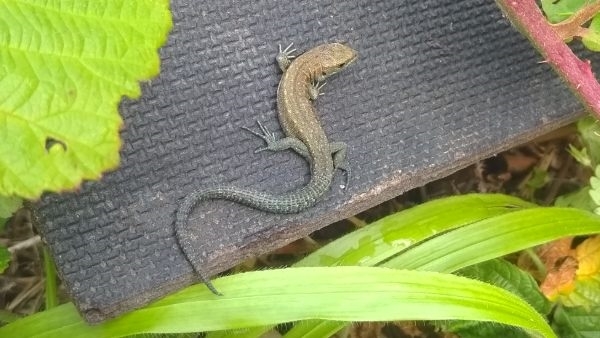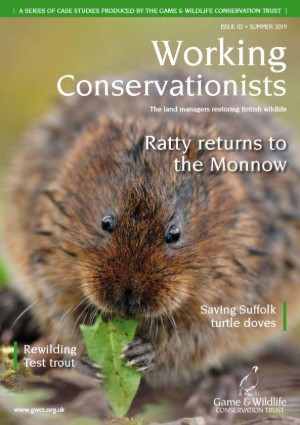Common lizard
Lizards sound a bit exotic for Old Blighty, don’t they? Well we actually have three native species here in Britain, the commonest of which is the viviparous or common lizard, Zootoca vivipara. The others are the legless slowworm and the sand lizard (the latter is very rare and confined to sandy heathlands). We have isolated populations of another two species: the western green lizard and the wall lizard, which are native to parts of Southern Europe but have been introduced here - or possibly hitchhiked in luggage.

Common lizards are fairly widespread - you can see them in sunny warm spots in most grassy and scrubby habitats, but especially on heaths and rough coastlines. About 10-15cm in length, they are quite variable in colour and their skin is covered in tiny scales, forming patterns of spots and stripes to camouflage them into their surroundings. Most are grey, brown or bronze, but some adult lizards can be olive-green and there are some rare all-black (melanistic) versions about.
They can be seen from early spring through until late autumn, but chances are particularly good on sunny mornings in April and October. They often have favoured basking spots, which are on top of or underneath a material that heats up quickly, like dry bare ground, dead grass, stones or man-made materials such as corrugated iron.
As cold-blooded animals, they need to bask in order to reach a body temperature of 30°C and activate their metabolism; cleverly, they can speed this up by flattening themselves to maximising their surface area. They need lots of food to get into breeding condition ahead of summer, and equally lots in autumn to fatten up before hibernation in winter.
They bed down for the cold months in groups, amongst rocks or dead wood and occasionally they may take advantage of milder patches of weather to come out and top up their energy reserves. I wonder if, like hedgehogs, lizards fall foul of Bonfire Night – a lovely warm pile of dry logs to hibernate in and bask on, until they get more heat than they bargained for!
Common lizards move as quick as lightning when they are warmed up. In addition to speed and disguise they rely on sight, scent and hearing for hunting. Their ears – little dark holes in the sides of their heads – are adapted to pick up sensitive earth-borne vibrations rather than aerial sound waves. Their prey – spiders, flies, grasshoppers, slugs, and small beetles – is tracked down, caught and shaken until stunned before being swallowed.
They have an interesting courtship; you could say it is founded on a ‘love bite’. The male seeks out a potential breeding female, and grabs her head in his jaws. If she is receptive she will mate with him, but if not she will bite him back fiercely in retaliation!
Unlike many other lizards, which lay eggs, a female will have a litter of up to seven hatchlings which are born in a flimsy egg sac which bursts before or shortly after birth (its scientific name ‘vivipara’ means ‘live birth’). This seems to be an adaptation to a cool climate – the young are better buffered against temperature fluctuations if they are kept inside, rather than laying there in a cold egg! To support the theory, some populations in warmer European countries defy their ‘vivipara’ label and lay properly formed eggs.
Lizards are eaten by many predators including raptors, jays, pheasants, foxes, cats and snakes. Like many other lizards, it can shed its tail when threatened, leaving a wriggling decoy to fool the predator whilst it makes its escape. It grows again, but usually in a darker, shinier form, giving the lizard a sort of Frankenstein appearance until the tail is complete and the scales turn their regular colour. Speed and camouflage are their main defence, plus they can swim and even dive if necessary!
The status of our common lizard population is generally uncertain, given the challenges of monitoring them, but it is presumed to be declining in the same way as other casualties of habitat loss. I think they are overlooked as well – in fact many people I speak to in my course of work have no idea we have lizards here and would probably confuse them with newts. To increase your chance of seeing a lizard (or any of our reptiles) put out a bit of corrugated iron or roofing onduline near a bit of scrub, leave it a few weeks and then stealthily approach it on sunny mornings in spring and autumn… and hope you’re quick enough!
Jess Brooks
Advisory

Our second issue of Working Conservationists, this 40-page A4-size colour publication features eight case studies produced by the GWCT, focusing on the land managers who are helping to save British wildlife.
Buy Now - £3.95 >
eBook - Buy Now - £1.99 >